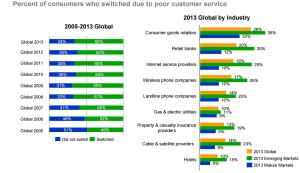Artificial Intelligence is dramatically changing business, and chatbots. Fueled by AI, are becoming a viable customer service channel. The best ones deliver a customer experience (CX) in which customers cannot tell if they are communicating with a human or a computer. AI has come a long way in recognizing the content – and context – of customers’ requests and questions.
Even well known Google put it’s hands on this topic !
Typically, customer service chatbots answer questions based on key words. The most basic systems are actually document retrieval systems. Sometimes this is frustrating. Think of the times you may have asked “Siri” or “Alexa” a question and received the wrong answer. The computer recognizes key words but may not recognize the context in which they are being used. In other words, the computer doesn’t recognize the way people naturally speak. This causes the customer great frustration. However, these systems (including Siri and Alexa) have come a long way and continue to improve.
Here are four ways AI and chatbots are creating a major impact in the customer service and CX world:
1. The chatbot never sleeps: Customer service is all about convenience, which includes 24/7 customer support. A cost-efficient, yet powerful way to provide basic support is through the never-sleeping chatbot.
2. The chatbot won’t make you wait: The concept of on-hold music is a friction point in customer service. With chatbots, you no longer have to wait for the next agent.
3. Personalizing the customer experience: Chatbots excel at collecting customer data from support interactions. After all, it’s the computer that’s doing the work. The advantage is that live support agents can use this information to personalize their interactions with customers.
4. Chatbots make friends and build relationships: Most companies wish their agents had more time to make outbound, proactive contact with their customers. Chatbots are there to help, and in some ways, they are revolutionizing the way brands stay in touch with their customers.
*On Microsoft’s chanel on YouTube we can find an interesting video about the most famous cafe at the moment*
Also we should emphasise…
- Enhanced self-service capabilities: AI-powered chatbots can provide customers with quick access to relevant information and resources, enabling them to resolve their queries or issues independently. This self-service aspect saves time for both customers and support agents, while empowering customers to find solutions on their own.
- Multilingual support: AI chatbots are capable of interacting with customers in multiple languages, enabling businesses to cater to a global customer base without requiring a large team of multilingual support agents. This helps companies expand their reach and provide personalized experiences to customers in different regions.
- Seamless integration with other platforms: AI chatbots can seamlessly integrate with various communication channels, including websites, messaging apps, social media platforms, and even voice assistants. This level of versatility allows businesses to engage with customers on platforms they prefer, making it easier for customers to reach out for support or inquire about products/services.
- Continuous learning and improvement: AI-powered chatbots have the ability to learn from each interaction and improve over time by analyzing data. They can understand patterns, customer preferences, and frequently asked questions, enabling them to refine their responses and deliver more accurate and relevant information to customers.
- Cost-effectiveness and scalability: Implementing AI chatbots can offer cost savings for businesses, as they eliminate the need for a large support team to handle repetitive queries. Chatbots can handle a high volume of inquiries simultaneously, ensuring quick responses and reducing the chances of customer frustration. This scalability makes them ideal for businesses with growing customer bases or seasonal spikes in customer service demands.
THE END
In conclusion, AI and chatbots are transforming customer service by for example providing 24/7 support, eliminating wait times, personalizing experiences, and enabling proactive customer engagement. As these technologies continue to evolve, businesses can benefit from enhanced self-service capabilities, multilingual support, seamless integration, continuous learning, cost-effectiveness, and growing empathy. By embracing AI and chatbots, companies can elevate their customer service and deliver exceptional support to their valued customers.
Sources:
Own experience.



